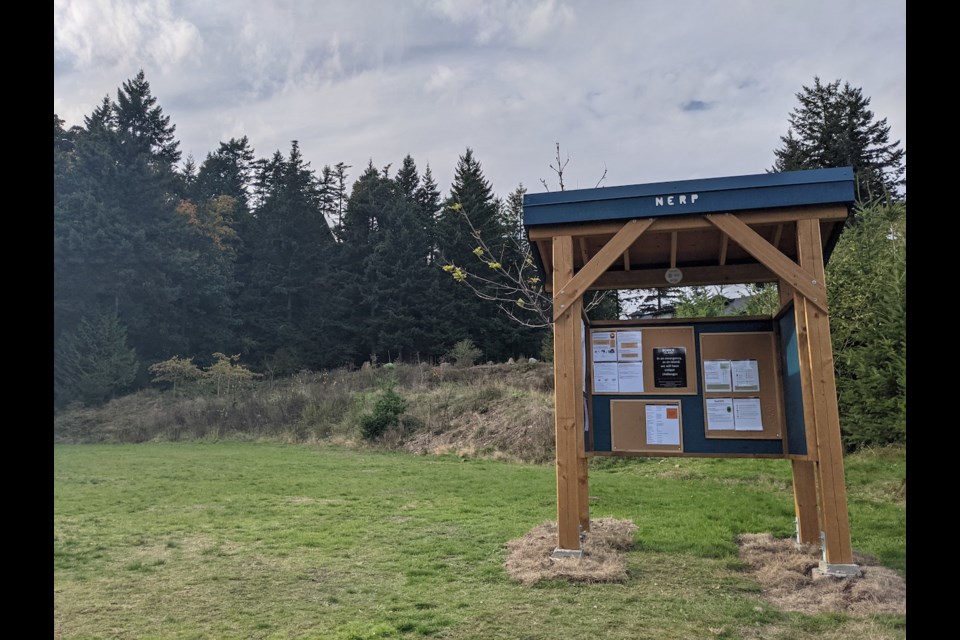The social media mega empire of Facebook, WhatsApp and Instagram crashing for more than five hours Monday was just a small taste of the communication nightmare that could happen in the event of a disaster on Bowen. If internet and cell service stopped working, where would we get information?
Thanks to the Neighbourhood Emergency Response Program (NERP), we’d go old school.
NERP is building neighbourhood information kiosks, ultimately envisioned as emergency hubs, around the island. They’re starting with five kiosks but NERP coordinator Edward Wachtman ultimately hopes to see 10 to 12 kiosks strategically placed around the island.
“We live on an island and if something serious happens, the shit hits the fan,” said Wachtman.
NERP is a municipally run program of volunteers dedicated to increasing individuals’ and neighbourhoods’ preparedness for emergencies (wildfire, earthquake, extended power outage, pandemic). In 2020, the program had just begun to rebuild momentum after a few years of dormancy when COVID-19 hit and regular Bowen activity was thrown off-kilter. NERP volunteers realized that there were a number of islanders who stayed at home – because of mobility challenges or other reasons – and who didn’t use social media or even necessarily have an email address. “For some, we didn’t even know who they were in the neighbourhoods,” said Wachtman.
NERPers took a page from the past and posted physical notes about town – if you’re in need of help, call so-and-so and if you can offer help, call so-and-so. The problem was, where to post. Temporary bulletin boards were erected in Tunstall Bay next to mailboxes and in Eagle Cliff, Melissa Crenshaw (the area’s NERP zone coordinator) started posting information in the neighbourhood’s decaying shelter.
“Melissa saw an opportunity to do two things: to replace the shelter because it wasn’t going to be standing very much longer and to set it up so eventually it could turn into an emergency hub,” explained Wachtman. “And she inspired us to do the same.”
Crenshaw spurred the Eagle Cliff Neighbourhood Association into entering into a collaborative services agreement with the municipality to rebuild the shelter.
In the meantime, NERPers started contemplating their own kiosk project. Architect Robyn Fenton of Tectonic Architecture, designed a structure and Doug Nash built the prototype. Daron Jennings of Bowen Properties meanwhile contributed background guidance.
Through a $15,000 Bowen Island Community Foundation Resiliency Fund grant, NERP bought enough supplies for five kiosks, managing to purchase the supplies before lumber prices skyrocketed. The cost of each kiosk came out to between $3,500 and $4,500, including materials and labour. (Milcon Construction took on the job for a nominal fee.) Eagle Cliff wound up merging its project with NERP’s – the neighbourhood contributing a couple thousand dollars to the project.
Four out of the first five kiosks are now built (Cates Hill, Eagle Cliff, Miller’s Landing and Bowen Bay) with one more coming in the Mount Gardner area.
The idea is to get people to regularly stop and look at the kiosks, so Wachtman encourages people to post neighbourhood information – garage sales, local notices and such. “They are set up to be information centres, where people can post and look for information.”
The vision is to have emergency equipment at the kiosks: pop up tents, first aid kits, solar panels for charging phones and the like.
A ribbon-cutting ceremony for the Cates Hill kiosk Saturday morning brought together some of the movers and shakers who got the project off of the ground – including NERP’s Judi Gedye, the community foundation’s Holly Graff, Mayor Gary Ander, fire chief Aaron Hanen, Cates Hill Community Association’s Phil Adkins, current BIM emergency coordinator Christie Stashyn and former BIM emergency program coordinator Jennifer McGowan. “It’s not the end of the journey, it’s a milestone and we wanted to take time to pause, reflect and acknowledge the people who got us here,” said Wachtman.
It wasn’t an easy project to get this far. “We thought we were putting four posts in the ground with a roof,” he remembered. But riparian zone assessments, structural engineering reports and the like created a few hurdles.
“We have a design concept. We have a list of materials. We know how to do it. And that’s the important part,” said Wachtman.
Now, they just need to find more money for more kiosks.
NERP now boasts about 90 volunteers, but they’re always looking for more. If interested in contributing toward neighbourhood preparedness, email [email protected].



